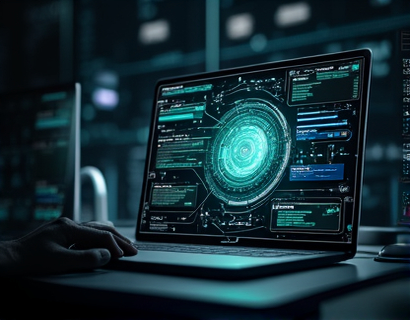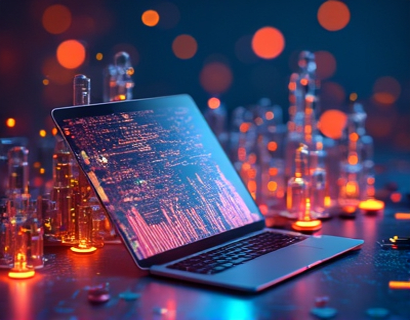Transforming Productivity and App Accessibility with AI and Crypto: Next-Gen Digital Solutions
The integration of Artificial Intelligence (AI) and cryptocurrency is revolutionizing the digital landscape, offering unprecedented opportunities to enhance productivity and improve app accessibility. This fusion of technologies is not just a trend but a transformative shift that is redefining how we interact with digital tools and manage tasks. For tech enthusiasts and early adopters, understanding the potential of these combined forces is crucial. This article delves into the innovative digital solutions that leverage AI and cryptocurrency to create a more efficient, secure, and user-friendly digital environment.
The foundation of this transformation lies in the unique properties of blockchain technology, the backbone of cryptocurrency. Blockchain's decentralized and transparent nature ensures that transactions are secure and immutable, reducing the risk of fraud and enhancing trust. When combined with AI, which excels in pattern recognition, predictive analytics, and automation, the potential for creating smart, adaptive, and secure applications becomes immense. These technologies, when integrated, can optimize workflows, automate repetitive tasks, and provide users with intuitive and personalized experiences.
Enhancing Productivity with AI-Powered Tools
One of the most significant impacts of AI in the digital realm is the enhancement of productivity tools. Traditional task management applications are being upgraded with AI capabilities, allowing for smarter scheduling, automated reminders, and predictive task prioritization. For instance, AI algorithms can analyze a user's past behavior and preferences to suggest optimal times for tasks, ensuring that critical activities are completed during peak productivity periods. This level of personalization not only saves time but also reduces stress and increases overall efficiency.
Moreover, AI-driven chatbots and virtual assistants are becoming indispensable in managing daily tasks. These AI entities can handle a wide range of functions, from booking appointments and managing emails to providing real-time information and support. By offloading these tasks to AI, users can focus on more strategic and creative work, leading to higher productivity and job satisfaction. The seamless integration of AI into these tools ensures that they learn and adapt over time, becoming more effective and user-friendly with each interaction.
Improving App Accessibility through AI and Crypto
Accessibility is a critical aspect of digital innovation, ensuring that technology is usable by everyone, regardless of their abilities. AI and cryptocurrency are playing pivotal roles in making apps more accessible. For users with disabilities, AI-powered tools can provide tailored experiences that accommodate various needs. For example, AI-driven voice recognition and text-to-speech technologies enable individuals with visual impairments to navigate apps more easily. Similarly, AI can enhance the accessibility of apps for users with motor disabilities by predicting and automating complex gestures.
Cryptocurrency adds another layer of accessibility by facilitating micropayments and subscription models that are both secure and user-friendly. Traditional payment systems often pose barriers for users, especially those in regions with limited financial infrastructure. Cryptocurrency, with its decentralized and low-transaction-fee nature, allows for seamless and instant payments, making premium features and services more accessible to a broader audience. This democratization of access ensures that innovative digital solutions can reach and benefit users worldwide, regardless of their economic background.
Security and Trust in Digital Transactions
Security is a paramount concern in the digital age, and the combination of AI and cryptocurrency offers robust solutions to enhance data protection and user trust. Blockchain's inherent security features, such as cryptographic hashing and consensus mechanisms, ensure that data is tamper-proof and transparent. AI, on the other hand, can detect and mitigate potential security threats in real-time, providing an additional layer of protection against cyber attacks. This synergy creates a highly secure environment for users, fostering confidence in digital transactions and data sharing.
Smart contracts, a key application of blockchain, further enhance security and trust. These self-executing contracts with the terms directly written into code can automate and enforce agreements without the need for intermediaries. AI can optimize smart contracts by analyzing patterns and predicting potential vulnerabilities, ensuring that the contracts are both secure and efficient. This combination not only streamlines processes but also builds trust among users, encouraging wider adoption of these technologies.
Innovative Use Cases and Future Potential
The potential applications of AI and cryptocurrency in digital solutions are vast and varied. In the realm of project management, AI-powered platforms can integrate blockchain to create transparent and tamper-proof task tracking systems. Team members can verify the completion of tasks and receive payments automatically, ensuring accountability and efficiency. This integration not only simplifies project management but also reduces the risk of fraud and errors.
In the healthcare sector, AI and cryptocurrency can revolutionize patient data management and telemedicine. AI algorithms can analyze medical data to provide personalized treatment recommendations, while blockchain ensures that patient data is securely stored and shared only with authorized parties. Cryptocurrency can facilitate secure and anonymous micropayments for teleconsultations, making healthcare more accessible and affordable. This fusion of technologies has the potential to transform how healthcare services are delivered, making them more efficient and patient-centric.
Another exciting area is the development of decentralized applications (dApps) that leverage both AI and blockchain. dApps can offer users greater control over their data and interactions, reducing reliance on centralized platforms. AI can enhance the functionality of these apps by providing intelligent recommendations, personalized user interfaces, and automated processes. The decentralized nature of blockchain ensures that these apps are resilient to censorship and downtime, offering a more reliable and user-friendly experience.
Challenges and Considerations
While the integration of AI and cryptocurrency offers numerous benefits, it also presents challenges that need to be addressed. One of the primary concerns is the technical complexity involved in developing and maintaining these systems. Developers must have a deep understanding of both AI algorithms and blockchain technology to create robust and efficient solutions. Additionally, the regulatory landscape for cryptocurrency is still evolving, and compliance with varying laws and standards can be a hurdle for businesses looking to adopt these technologies.
Another consideration is the energy consumption associated with blockchain, particularly proof-of-work systems. The environmental impact of mining cryptocurrencies has been a point of contention, and the industry is actively exploring more sustainable alternatives like proof-of-stake. AI, while powerful, also requires significant computational resources, which can contribute to energy usage. Balancing innovation with sustainability is crucial for the long-term viability of these technologies.
Conclusion
The fusion of AI and cryptocurrency is ushering in a new era of digital innovation, transforming productivity and app accessibility in ways previously unimaginable. By leveraging the strengths of both technologies, we can create smarter, more secure, and more inclusive digital solutions. For tech enthusiasts and early adopters, embracing these advancements is not just about staying ahead of the curve but about shaping the future of how we work and interact with technology. As these technologies continue to evolve, the possibilities for enhancing our digital lives are endless.










































